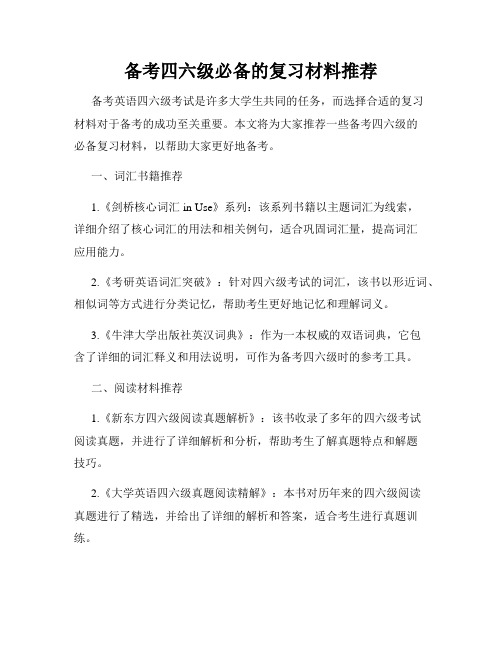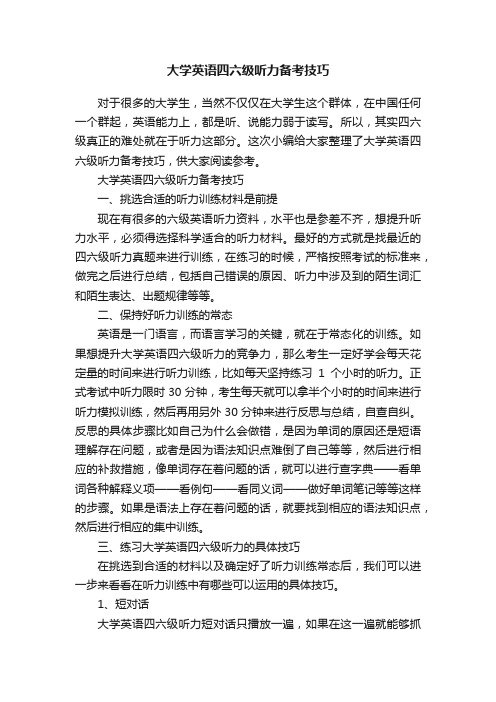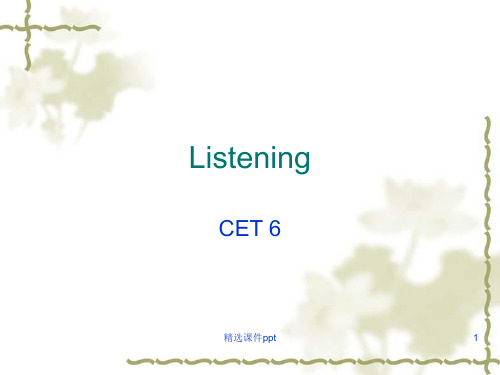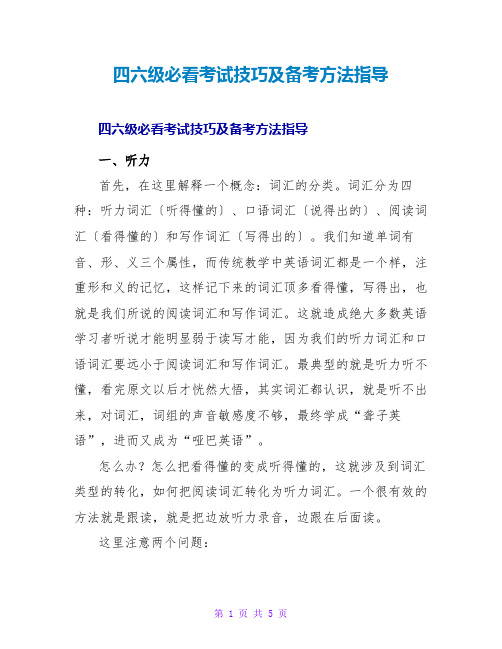大学英语四六级听力备考宝典
- 格式:doc
- 大小:32.00 KB
- 文档页数:3

备考四六级必备的复习材料推荐备考英语四六级考试是许多大学生共同的任务,而选择合适的复习材料对于备考的成功至关重要。
本文将为大家推荐一些备考四六级的必备复习材料,以帮助大家更好地备考。
一、词汇书籍推荐1.《剑桥核心词汇 in Use》系列:该系列书籍以主题词汇为线索,详细介绍了核心词汇的用法和相关例句,适合巩固词汇量,提高词汇应用能力。
2.《考研英语词汇突破》:针对四六级考试的词汇,该书以形近词、相似词等方式进行分类记忆,帮助考生更好地记忆和理解词义。
3.《牛津大学出版社英汉词典》:作为一本权威的双语词典,它包含了详细的词汇释义和用法说明,可作为备考四六级时的参考工具。
二、阅读材料推荐1.《新东方四六级阅读真题解析》:该书收录了多年的四六级考试阅读真题,并进行了详细解析和分析,帮助考生了解真题特点和解题技巧。
2.《大学英语四六级真题阅读精解》:本书对历年来的四六级阅读真题进行了精选,并给出了详细的解析和答案,适合考生进行真题训练。
3.英文报纸和杂志:阅读英文报纸和杂志是提高阅读水平的有效途径,考生可以选择《纽约时报》、《经济学人》等优秀的英文报纸和杂志进行阅读。
三、听力材料推荐1.《新东方四六级听力真题解析》:该书收录了多年的四六级听力真题,并对每篇听力进行了详细解析和讲解,帮助考生熟悉听力题型和提高听力技巧。
2.《英语流行电影原声学习》:选择一些英语流行电影,通过观看电影并辅以字幕的方式进行听力训练,可以提高考生的听力理解和口语表达能力。
四、写作材料推荐1.《四六级写作备考指南》:该书由英语写作专家编写,对四六级写作的命题特点、写作技巧和常用表达进行了详细的介绍和讲解,适合考生备考写作部分。
2.英语写作网站和博客:考生可以通过阅读一些英语写作网站和博客,学习一些写作技巧和范文,如EssayShark和Write to Score等网站。
五、口语材料推荐1.《新东方四六级口语真题解析》:该书收录了多年的四六级口语真题,并对每个题目进行了详细解析和范例展示,帮助考生熟悉口语题型和提高口语表达能力。

保命180分英语四级听力进阶实战宝典—新闻听力真题模拟试题(第一套)1. A) Terrorists fought with Government troops.B) Thai troops killed terrorists.C) There were shootings.D) There were explosions.2. A) The Muslims wanted independence.B) Thai troops have been sent there.C) About 2,000 people have been killed.D) There have been more bombings since 2004.1. A) Terrorists fought with Governmenttroops.B) Thai troops killed terrorists.C) There were shootings.D) There were explosions.A) 恐怖分子与政府军队开战。
B) 泰国军方杀死了恐怖分子。
C) 发生了枪击案。
D) 发生了爆炸。
2. A) The Muslims wanted independence.B) Thai troops have been sent there.C) About 2,000 people have beenkilled.D) There have been more bombingssince 2004. A) 穆斯林要求独立。
B) 泰国军队已经被派往那里。
C) 约有2000人丧生。
D) 自从2004年以来已有多起爆炸发生。
【听前预测】1.四个选项都与发生的暴力事件有关,题目可能考查新闻中发生的具体事件。
2.四个选项都涉及暴力事件的具体信息,题目可能考查事件发生的原因。
[1] The New Year celebration in Thailand was shattered by violence, when nine bombs exploded across Bangkok around midnight. Three Thai citizens were killed and more than 30 injured. No terrorist group claimed responsibility for the bombings by Tuesday. Some believe the explosions were the work of Muslim separatists. Bombings and shootings occur almost daily in Thailand’s three Southern-most provinces. [2] Yala, Narathiwat and Pattani have a dominant Muslim population and have long complained of neglect and discrimination in the largely Buddhist nation. They have asked for independence and a separate Islamic State. Since 2004, the[1] 午夜,当九枚炸弹在曼谷各地爆炸的时候,泰国的新年庆祝活动被暴力破坏了。

大学英语四六级听力备考技巧对于很多的大学生,当然不仅仅在大学生这个群体,在中国任何一个群起,英语能力上,都是听、说能力弱于读写。
所以,其实四六级真正的难处就在于听力这部分。
这次小编给大家整理了大学英语四六级听力备考技巧,供大家阅读参考。
大学英语四六级听力备考技巧一、挑选合适的听力训练材料是前提现在有很多的六级英语听力资料,水平也是参差不齐,想提升听力水平,必须得选择科学适合的听力材料。
最好的方式就是找最近的四六级听力真题来进行训练,在练习的时候,严格按照考试的标准来,做完之后进行总结,包括自己错误的原因、听力中涉及到的陌生词汇和陌生表达、出题规律等等。
二、保持好听力训练的常态英语是一门语言,而语言学习的关键,就在于常态化的训练。
如果想提升大学英语四六级听力的竞争力,那么考生一定好学会每天花定量的时间来进行听力训练,比如每天坚持练习1个小时的听力。
正式考试中听力限时30分钟,考生每天就可以拿半个小时的时间来进行听力模拟训练,然后再用另外30分钟来进行反思与总结,自查自纠。
反思的具体步骤比如自己为什么会做错,是因为单词的原因还是短语理解存在问题,或者是因为语法知识点难倒了自己等等,然后进行相应的补救措施,像单词存在着问题的话,就可以进行查字典——看单词各种解释义项——看例句——看同义词——做好单词笔记等等这样的步骤。
如果是语法上存在着问题的话,就要找到相应的语法知识点,然后进行相应的集中训练。
三、练习大学英语四六级听力的具体技巧在挑选到合适的材料以及确定好了听力训练常态后,我们可以进一步来看看在听力训练中有哪些可以运用的具体技巧。
1、短对话大学英语四六级听力短对话只播放一遍,如果在这一遍就能够抓到足够多的信息并筛选出正确的答案呢?准确率最高的一种方式就是先大致浏览下答案选项,然后在听的过程中注重对于短对话的整体理解,千万不要听到什么选什么,因为这有可能就是陷阱,有可能被偷换了主语或者概念。
一般来说,在听力短对话这部分,答案基本上都是需要进行同义替换的。

英语四六级复习资料重点推荐英语四六级复习资料重点推荐一、英语四六级真题资料英语四六级真题复习资料推荐两个品牌的图书:一个是巨微《四级真题/逐句精解》,一个是星火的《真题详解+标准预测》。
巨微真题确实与众不同,将历年真题一句一句掰开揉碎进行解析,同时突出满分答题技巧的讲授,尤其适合基础不好的考生系统深入研读使用,大部分考生用了这本书一次性就过关了,口碑极好。
补充一点,不愿意背单词的同学,可以用巨微的真题背单词,这里面对词汇的解析超详细。
星火真题的解析则将对简单精炼,适合基础较好的同学在临考前突击使用。
大家可以根据各自基础情况选择适用,也可以前期和中期用巨微,后期用星火。
在整个复习资料中,真题最为重要,需要考生反复研读总结。
这一点尤为重要,考生不可不重视。
二、英语四六级听力复习资料考前需要转变策略,建议每天听一套真题听力,每一套都至少要听三遍,第一二遍做题,改题,第三遍听内容。
三、英语四六级阅读复习资料阅读书推荐新东方的阅读强化训练600题,该书题量较大,可以考虑作为泛读资料来看。
华研的新编大学英语四级阅读180篇也不错,题目解析相对详细。
至于要从根本上提升阅读能力,建议精读巨微的《逐句精解》,把历年四级真题中的文章一句一句进行分析,彻底搞透所涉及的语法和词汇。
切记:只有精读,才能从根本上提高阅读能力;只有真题,才能直击应试要害,让考生少走乃至不走弯路。
对于一般的阅读书,建议大家只看文章本身,不做具体的题目。
原因在于很多阅读数粗制滥造,题干设置根本不合理不科学,如果盲目不加选择地滥做题目,很可能导致应试思维被误导。
因此,做真题的意义一方面在于掌握语法、词汇和考点,更重要的理由在于正确把握命题思路,防止思维走偏。
四、英语四六级写作复习资料写作推荐一本王长喜的《12句作文法与3步翻译法》,以及华研的《写作范文100篇》。
写作翻译的专项教辅整体来讲质量平平,大家要向迅速提高写作,还是建议多研读真题当中的写作,多看好的真题解析书。

四六级听力技巧与答题技巧详解听力作为英语四六级考试的重要部分,对于考生来说是一个相对难以应对的挑战。
因此,掌握听力技巧和答题技巧成为提高听力分数的关键。
本文将详细讲解四六级听力技巧和答题技巧。
一、听力技巧1. 预测题目内容:在听力开始前,快速浏览题目,理解问题的要求和重点,尝试预测答案的范围以及可能的关键词。
这样能帮助你更有针对性地聆听对话或短文,提高听力的准确性。
2. 注意关键词:关注对话或短文中的关键词,这些词通常是信息传递的核心点。
将注意力集中在关键词上,可以更好地理解和抓住重要信息。
3. 聚焦一致性:听力材料中的对话或短文通常会就同一个话题进行不同方面的描述。
将握住主题的思路,把握对话或短文中重复出现的内容和信息,从而更好地理解整个材料。
4. 注意声调和语气:正确理解对话者的语气和声调可以帮助你把握对话的情感和意图。
特别是在多人对话中,对话者的语气和态度往往能明显干扰或暗示某些信息。
5. 标记重点信息:听力过程中,合理使用笔记、缩写和图表等方法,将听到的重要信息及时记录下来。
这样不仅有助于加深印象和理解,而且能够在后面的题目中提供便利。
二、答题技巧1. 利用选项消减法:在选择题中,单选和多选题通常提供几个选项。
利用所学的听力技巧,将不符合条件的选项逐一排除,最终选出正确答案。
这样可以提高选择题的答题准确性。
2. 注意选项词序:很多听力选项的干扰性在于选项词的词序和原文不一致。
在做题过程中,注意选项词的变化和顺序,避免由于这种干扰导致选项选择错误。
3. 捕捉细节信息:许多听力题目要求考生拾取细节信息。
在听力过程中,注意捕捉细节信息的同时,确保不丢失整体大意。
4. 注意时间提示:听力材料中经常会提到具体的时间信息,例如日期、时间段等。
捕捉这些信息并在答题时有效利用,有助于提高答题的准确度。
5. 学会揣测答案:有时候,无法听清或者无法确定答案的情况下,可以学会根据前后文的逻辑关系和常识进行揣测。

英语四级的听力部分备考资料推荐在备考英语四级听力部分时,选择合适的备考资料是至关重要的。
下面是一些备考英语四级听力部分的资料推荐,帮助您提高听力技巧和应试能力。
1. 《新视野大学英语听力教程》系列(New Horizon College English Listening Course)该系列教材由北外《新视野大学英语》编写组精心编纂,覆盖了四级听力部分的各个考点。
每个单元都包括了大量的听力素材,如短对话、长对话、讲座、新闻等。
同时,该系列教材还提供了丰富的听力训练和答题技巧,帮助学生提高听力水平。
2. 《剑桥大学四级考试听力真题训练》(Cambridge English: Firstfor Schools Trainer)《剑桥大学四级考试听力真题训练》是由剑桥大学出版社出版的备考资料。
该资料提供了多个真实的四级听力考试题目,包括短对话、长对话、讲座等。
学生可以通过练习这些题目,了解考试的出题风格和要求,提高应试能力。
3. 听力APP现如今,市面上有许多专门用于英语听力训练的APP,如扇贝听力、石墨听力等。
这些APP提供了大量的听力材料,包括各类听力题目和真实对话,有助于提高学生的听力技巧和词汇量。
此外,这些APP还提供了方便的自主学习功能,适合学生随时随地进行听力练习。
4. 在线听力课程许多在线学习平台提供了英语听力课程,如MOOC(慕课)平台、VIPKID、51Talk等。
这些课程通常由资深教师主讲,提供丰富的听力练习材料和答题技巧,有助于提高听力水平。
综上所述,备考英语四级听力部分时,可以选择适合自己的备考资料。
以上推荐的资料包括教材、真题训练、APP和在线听力课程,学生可根据自身情况选择适合自己的学习方式。
通过持续的练习和积极的学习态度,相信您一定能够在英语四级听力考试中取得好成绩!。

英语四级备考资料推荐近年来,英语四级考试不仅是提高大学生综合英语能力,也是让学生在求职过程中更有竞争力的一项重要资格证书。
为了帮助广大考生更好地备考,以下是一些备考资料的推荐。
一、教材类1. 《大学英语四级考试全真模拟试卷》出版机构:外语教学与研究出版社该书是按四级考试标准编写的全真模拟试卷,包括听力、阅读、写作和翻译等各个部分的练习题,可以帮助考生熟悉考试形式和题型,提高应试能力。
2. 《新东方•四级英语真题精析》出版机构:外语教学与研究出版社这本书收录了历年来的四级真题,并提供了详细的解析和答案。
通过学习真题,考生可以了解考试重点和出题规律,有针对性地进行备考。
二、听力类1. 《新东方•四级听力》出版机构:外语教学与研究出版社这本书提供了大量的四级听力练习题,包括短对话、长对话、听力理解和听写等不同题型,以帮助考生提高听力水平和应试能力。
2. 《新东方•听力突破》出版机构:外语教学与研究出版社这本书针对四级考试中的听力部分进行了深入讲解,并提供了大量的听力材料和练习题。
通过学习和练习,考生可以更好地掌握听力技巧和应对策略。
三、阅读类1. 《新东方•四级阅读》出版机构:外语教学与研究出版社这本书根据四级考试的阅读题型,提供了大量的文章和阅读理解题目。
通过针对性的练习,考生可以提高阅读速度和理解能力。
2. 《四级阅读必备365篇》出版机构:北京理工大学出版社这本书收录了365篇四级阅读材料,涵盖了各种题材和难度,可以帮助考生拓展阅读领域,提高语言理解和应试能力。
四、写作类1. 《新东方•四级写作》出版机构:外语教学与研究出版社这本书通过讲解写作的基本结构和技巧,提供了大量的写作例子和练习题,帮助考生掌握四级写作的要点和方法。
2. 《四级高分作文范文集》出版机构:外语教育出版社这本书收录了大量的四级高分作文范文,通过分析和模仿范文,考生可以提升自己的写作水平和应试能力。
综上所述,以上推荐的备考资料涵盖了四级考试的各个部分,通过练习这些资料,考生可以提高听说读写的综合能力,更好地备战四级考试。

2019年大学英语四六级必备宝典本文档主要分为两部分,前半部分是cet6,后半部分是cet4。
.CET6资料大全(很实用噢).................................. 错误!未定义书签。
六级在考试内容方面与与四级的区别 .. (64)CET-4资料大全(完整版) (146)英语四六级考试题型:计分规则2019年上半年大学英语六级考试将在6月18日15:00-17:20举行,下半年将在12月17日15:00-17:20举行,为了帮助大家有效的报考复习,考试大外语站点编辑收集整理了相关信息供大家参考,希望对大家有所帮助,考试大祝大家顺利通过考试!六级考试各部分测试内容、题型和所占分值比例如表所示:写作:33分--条理不清、思路紊乱,语言支离破碎或大部分句子均有错误,且多数为严重错误。
39分--基本切题。
表达思想不清楚连贯性差。
有较多严重的语言错误。
45分--基本切题。
有些地方表达思想不够清楚,文字勉强连贯;语言错误相当多,其中有一些是严重错误。
57分--切题。
表达思想清楚,文字连贯,但有少量语言错误。
67分--切题。
表达思想清楚,文字通顺。
连贯性较好,基本上无语言错误,仅有个别小错。
文字不足酌情扣分:100-119扣1分;90-99扣3分;80-89扣4分;70-79扣5分;60-69扣6分;50-59扣7分;不足50扣9分。
听力:听力理解共35个,包括短对话、长对话、短文听力及短文听写:听力对话及短文听力共25题,每1题算1个,共25个;短文听写共11题,其中单词听写8题,每2题算1个,句子听写共2题,每1题算2个,共10个。
阅读:阅读理解共35个,包括快速阅读,篇章词汇或短句问答,篇章阅读:快速阅读共10题,每1题算1个,共10个;篇章词汇每2个空算1个,短句问答共5题或8题,每1题算1个或0.625个,共5个;篇章阅读共10题,每1题算2个,共20个。
综合:综合测试共15个,包括完形或改错,翻译。



英语四级听力训练材料推荐英语四级考试是学生们非常重要的一门考试,其中听力部分是考试的一大难点。
为了帮助学生们提高听力水平并取得更好的成绩,本文将推荐几份优质的英语四级听力训练材料。
1. 《新东方·四级听力》《新东方·四级听力》是很多学生们备考四级听力的首选材料之一。
本套教材以真题为基础,精选了大量的四级听力练习题和模拟试题。
该教材从基础的听力技巧培养开始,逐步提高学生们的听力能力,并针对四级考试的特点进行了有针对性的训练。
2. 《剑桥四级真题集》《剑桥四级真题集》是一个非常经典的四级听力训练材料,它包含了多年来的真实考试题目,可以帮助学生们更好地了解四级听力考试的形式和要求。
这本教材不仅提供了大量的听力材料和练习题,还有详细的听力解析和答案,方便学生们进行自我评估和复习。
3. 英语四级线上听力课程现在网络时代,有很多线上听力课程可以选择。
这些课程通常由经验丰富的英语老师授课,内容涵盖了四级听力的各个方面。
通过参加线上听力课程,学生们可以在老师的指导下,系统地进行听力训练,并进行互动交流,解决自己在听力学习中遇到的问题。
4. 英语四级听力APP现在市面上有很多专门用于英语听力训练的手机应用程序,例如“扇贝听力”、“英语流利说”等。
这些APP提供了丰富多样的听力材料,并配备了智能化的评估系统,可以根据学生们的听力反馈情况进行个性化的学习推荐和评估。
总结起来,提高英语四级听力水平是需要积累和坚持的过程。
通过选择适合自己的训练材料,并结合系统的练习和反馈,相信大家一定可以在四级听力考试中取得不错的成绩。
希望上述推荐的材料能够对你的学习有所帮助!。

四六级备考必读资料推荐备考四六级考试是每位英语学习者的重要任务,选择合适且优质的备考资料对于提高英语水平和应对考试至关重要。
本文将推荐几种必读的备考资料,帮助考生高效备考,取得优异的成绩。
一、词汇书籍推荐词汇是四六级考试中最基本的部分之一,扎实的词汇基础是理解和运用英语的关键。
以下是几本备考词汇的经典教材推荐:1. 《考研英语词汇》这本教材是备考研究生英语考试的知名教材,其中收录了四六级考试常见的高频词汇,适合用于备考四六级考试。
2. 《新东方·四六级词汇考点精析》这本教材是新东方教育集团旗下的备考资料,根据四六级考试的特点,总结了各类词汇考点,帮助考生更好地理解和记忆英语词汇。
3. 《剑桥雅思词汇手册》即使是备考雅思考试的词汇书籍,也对于四六级备考有一定参考价值。
这本词汇手册收录了雅思考试中的高频词汇,适合考生做补充和拓展。
二、阅读参考资料推荐阅读理解是四六级考试中难度较高的一部分,通过阅读大量英语文章可以提高理解和阅读速度。
以下是几本备考阅读的推荐资料:1. 《大学英语四六级长阅读教程》这本教材是备考四六级考试常用的阅读资料,包含了各种题型的长篇阅读材料,帮助考生熟悉考试题型和解题技巧。
2. 《新视野大学英语》系列教材新视野系列教材是大多数高校英语教材,其中的阅读部分涵盖了四六级考试的相关题型,同时还有对应的听力和口语部分,对于全面备考有一定的帮助。
3. 《英语学术阅读》对于准备深入学术领域或者将来需要进行学术研究的考生来说,这本书是一本不错的选择。
阅读学术文章能提高英语阅读水平并提供专业背景知识。
三、听力练习材料推荐四六级考试中的听力部分对于大部分考生来说是一大难点,通过大量的听力练习可以提高听力技能。
以下是几个备考听力的推荐资源:1. 《四级听力宝典》这套教材是备考四级听力的经典教材之一,包含各种题型的听力材料和解题技巧,帮助考生熟悉考试要求和提高听力水平。
2. 《快乐英语听力》这套系列教材适合考生自学和练习,在听力技巧和答题方法上提供了详细的指导,有助于提高考生的听力能力。

一、关于听力!!!第一招:相关保留原则当选项中有两项表达意思相近时,那么正确答案必在这两项之中!这时只需稍微听一听对话,即可知答案,如果出现了双重相关,便可直接确认正确选项,只需听完对话加之认证一下即可!典型例题:4. A) Visiting the Browning.B) Writing a postcard.C) Looking for a postcard.D) Filling in a form.例题分析:B、C两项均含有 a poscard ,B、D两项均含有写...之意,即B、C和B、D构成双重相关,即可得出B为正确选项!本题听力原文:4. M: What\'s the matter? You\'ve been sitting there for ages, just staring into space.W: I told the Browning I\'d send them a postcard. Now I don\'t know what to say.Q: What\'s the woman doing?第二招:异项保留原则当选项中出现有意思明显相反的两项时,那么正确答案必在此二项中出现!如果出现双重异项,那么即可判断出正确答案,异项保留原则在六级考试听力短对话中应用广泛!典型例题:6. A) She can’t finish her assignment, either.B) She can’t afford a computer right now.C) The man can use her computer.D) The man should buy a computer right away.例题分析:A、B异项,A项的意思是她现在有电脑,B项的意思则是她现在没有电脑。
B、D异项,B是说女方无电脑,而D是说男方无电脑,男女也是一种反意关系。

真题:20XX年12月大学英语四级【真题】听力录音下载1993年1月-20XX年6月大学英语四级听力原文+试题+答案+mp3(33套)[原创]大家版收藏级大学英语四级历年真题大全(89-07年39套)文本及听力cet4考试必备英语四级听力[原文mp3下载汇总新书:长喜英语四级听力必备知识及各类词汇2010版长喜《英语4级标准听力》电子书及MP3新东方大学英语考试四级听力笔记电子书及mp3下载《星火英语新题型大学英语4级考试听力题源精选720题(2010下)》(PDF+MP3)下载《星火英语新题型大学英语4级考试听力高分特训(2010下)》(PDF+MP3)下载长喜20XX年6月英语四级标准听力4套文本及mp3下载[大家网首发]星火20XX年6月英语四级听力高分突破-5套模拟电子书及MP3含字幕20XX年12日(CET4)英语四级听力精练汇总[原创]大家版收藏级大学英语四级历年真题大全(89-20XX年)文本及听力大学英语四级考试巅峰听力2007版(MP3含字幕)[王长喜编]20XX年12月英语四六级听力快速提高必经五个阶段及资料[CET4新题型]听力16.0课时[张杨Flash]听力备考专题听力资料:[CET4新题型]听力16.0课时[张杨Flash]大学英语四级考试巅峰听力2007版(MP3含字幕)[王长喜编]星火4级听力满分15天音频4级听力满分15天五套模拟题音频新东方语音教练笔记1-2CET4新题型听力张杨教案跟听15天大学英语四级听力得满分mp3大学英语四级最新题型-听力理解(mp3+pdf文本)新东方_大学英语四级_听力特训之附赠MP3光盘-430分钟全外研社《四六级备考宝典》听力试题MP3下载上海新东方四级听力笔记下载技巧方法:英语四级听力30天学习笔记word下载英语四级听力60个必考习语word下载20XX年英语四级听力复合式听写攻略:应试技巧20XX年6月四级听力备考:调整心态及快速记忆20XX年6月英语新四级考试听力长对话应试策略过关斩将:大学英语四级听力得分秘笈大学英语四级短文听力解题对策英语四级听力选择题解题妙计英语四级听力语段题十大标志词英语四级听力训练有方英语四级听力常考场景词及规律掌握英语四级听力的技巧突破英语四级听力难关英语四级六级听力常考态度词大学英语四级短文听力的提问方式及解题对策四级听力备考词组惯用语及特殊表达英语四级听力备考注意失爆与连读三大考场要诀应对英语四级考试听力听力练习:大学英语四级听力考试预测(在线听力及原文)25篇汇总大学英语四级听力模拟训练(在线听力及原文)13篇汇总。

四六级必看考试技巧及备考方法指导四六级必看考试技巧及备考方法指导一、听力首先,在这里解释一个概念:词汇的分类。
词汇分为四种:听力词汇〔听得懂的〕、口语词汇〔说得出的〕、阅读词汇〔看得懂的〕和写作词汇〔写得出的〕。
我们知道单词有音、形、义三个属性,而传统教学中英语词汇都是一个样,注重形和义的记忆,这样记下来的词汇顶多看得懂,写得出,也就是我们所说的阅读词汇和写作词汇。
这就造成绝大多数英语学习者听说才能明显弱于读写才能,因为我们的听力词汇和口语词汇要远小于阅读词汇和写作词汇。
最典型的就是听力听不懂,看完原文以后才恍然大悟,其实词汇都认识,就是听不出来,对词汇,词组的声音敏感度不够,最终学成“聋子英语”,进而又成为“哑巴英语”。
怎么办?怎么把看得懂的变成听得懂的,这就涉及到词汇类型的转化,如何把阅读词汇转化为听力词汇。
一个很有效的方法就是跟读,就是把边放听力录音,边跟在后面读。
这里注意两个问题:1、录音不要放放停停,不要暂停录音,这里训练的就是你的边听边读,一心二用的才能。
〔当然初学者可以渐渐来,直到逐渐不用暂停,逐渐尝试高语速的听力材料。
〕2、跟读时不要看文本,不要借助文字,这里训练的就是你的词汇转化,听力词汇的才能。
〔同样初学者要一步一步来,直到逐渐摆脱文本,逐渐由小段跟读到大段地跟读。
〕四六级听力中大家要注意的.是速记。
这里同样要注意两个问题:1、所谓速记就是把听到的,迅速的通过笔记协助大脑记忆,注意,这里是协助,不是代替,也就是说笔记的功能是帮助你回忆,记完笔记是要回头整理的,所以只要笔记能看懂就可以,不一定要是单词,汉字、图画、符号、数字、任何能让你回忆起当时听到的词汇就可以。
切忌完美,把这个空的单词写完后录音已经读过好几个空,你自己都找不到了。
关于速记符号建议大家花点时间,拿几套真题,把听写局部的词汇汇总一下,自己揣摩一下,形成自己的速记符号。
因为速记贵在迅速、习惯而不是标准,狂草?没关系的,只要自己能根据它回想起当时的那个单词就可以!2、速记也讲究的是一心二用,这里是边听边写。

历年来许多考生在听力上失分都比较多,听力是考试难点,因其所占分值多也是重点。
命题内容1.四级听力:共包含三个题型,分别是:Section A 短篇新闻(3篇,共有3段,每段提2~3个问题,共7题); Section B 长对话(2篇,每篇240~280词,提4个问题,共8题);Section C 听力篇章(3篇短文,每篇短文220~240词,提3~4个问题,共10题)。
其中,四级短篇新闻和长对话,每题1分;四级听力篇章,每题2分。
2.六级听力:共包含三个题型,分别是:Section A 长对话(2篇,每篇长对话280~320词,提4个问题,共8题); Section B 听力篇章(2篇,每篇240~260词,提3~4个问题,共7题); Section C 讲座/讲话(3篇,共约1200词,每篇提3~4个问题,共10题)。
其中,六级长对话和听力篇章,每题1分;六级听力讲座/讲话,每题2分。
命题规律摸清往年出题规律,可总结为三大原则:1.顺序原则听力出题的顺序和听到的内容顺序一致:都是从前往后顺序出现的。
做题时应该根据顺序原则定位。
2.同义替换正确选项和对应的听力原文答案句存在同义替换现象,六级听力中尤其常见。
3.转折处常设出题点语音语调变化,如升降调表疑问、表转折等处常设考点。
所以相应地在做题时,应该注重抓听以下标志词:①最高级标志词The most/ chief / primary / main / lead②唯一级标志词only / unique / prefer / perfect③逻辑关系词a.注意表示转折和对比的逻辑词:but,however,nevertheless,while,in fact,whereas,unexpectedly,unfortunately,yet,except,on the other hand,compared to,unlike,instead,in contrast to等b.注意表示因果的逻辑词:as a result;since,due to;because of;therefore,thus,soc.注意表示否定的逻辑词:not,no,rarely,seldom,neverd.表让步的逻辑词:despite, in spite of, although, thoughe.总结项标志词all in all / in brief / to conclude / at last / in summary / in short提分宝典1.要采用科学的步骤来答题新东方在线建议大家按照以下三个步骤来解答听力题:Step 1: 听录音前要预读选项,预测录音内容和提问形式。

英语四六级考试必备资料四级考试听力短文题10大解题原则.1.听即原则:所听即所得,听到什么就选什么(正好与短对话相反,短对话时听到的一般不选)2.重读原则:某单词被反复读到或是在语音上加以重读,因引起重视如果选项中出现很可能是正确答案3.顺序原则:出题顺序一般与行文顺序相同除了主题题和部分说明文4.主题原则:主题一般出现在段落的头尾部分,所以要集中精力听清前三句话和最后两句话5.原因原则:凡出现表示原因,目的的很有可能是考点如:because so as 等词前后要着重听6.转则原则:凡出现表示转则的词如:but however yet 等,后面的句子往往是考点,要引起重视7.光明原则:事情一般都是向着好的方面发展的,主人公多数是大难不死的,事情总是逢凶化吉,绝处逢生的8.男女原则:同短对话9.穷学生原则:学生一般都是比较穷的,不能继续学业一般都是因为经济原因,因为穷一般还比较喜欢DIY一些东西10.偏怪小原则:一般故事总是稀奇古怪的,经过总是曲折离奇的,结局总是出人意料的。
宗旨就是意料之外、情理之考试听力短文题10大类标志词:2.唯一级标志词only / unique / prefer / every / one / of all / perfect / ……3.因果项标志词cause / lead to / contribute to / thanks to / owing to / question / answer / why / reason / 其他形式的问句/ ……4.转则项关键词despite / in spite of / instead / while / from ~ to ~ / although ~ (yet)~ / not only ~ but also ~ / ……5.序数项标志词所有的序数词(first , second)/ another / the other / next / last / in addition / on the other hand / ……6.时间项标志词when / how / today / as / before / after / since / then / unti l / ……7.解释项标志词or / namely / in other words / that is / that is to say / ……8.目的项标志词to / for / ……9.总结项标志词all in all / in brief / to conclude / at last / in summary / in short / ……10.强调项标志词副词:especially / particularly / almost / al ways / usually / …… 动词:show / remember / note / notice / say / pronounce / ……根据四级考试大纲,完型填空满分占710分的10%。

英语四级听力备考书籍推荐作为英语四级考试的一部分,听力是许多考生感到困惑和挑战的部分。
为了能够有效备考,选择适合的备考书籍是非常重要的。
以下是几本备考听力的书籍推荐,帮助你取得更好的成绩。
1.《四级听力突破》这本书由考试专家编写,提供了全面的听力技巧和策略。
本书分为不同的主题模块,包括日常生活、学术类、社会类和媒体类。
每个模块都包含了丰富的听力原文和相关练习,帮助考生提升听力理解能力。
2.《大学英语四级听力课堂》这本书是由一线听力教师编写的,内容紧密结合四级考试口语话题和听力文本。
书中提供了大量的练习,帮助学生熟悉听力考试的题型和题目要求。
此外,书中还包含了听力技巧和策略的详细介绍,帮助学生更好地应对考试中的难题。
3.《新视听说考试专项突破:英语四级听力》这本书注重培养学生的听力技巧和学术考试听力技巧。
书中包含了丰富的听力原文和题目,涵盖了多个主题和场景。
此外,书中还有相关的听力练习和答案详解,帮助学生进一步理解和掌握听力技巧。
4.《走向英语四级听力高手之路》这本书以全面讲述四级听力的考点和技巧为主题,系统地介绍了听力考试的各个方面。
书中提供了大量的听力例题和解析,帮助学生熟悉和掌握考试要求。
此外,书中还包含了模拟测试和答案解析,帮助学生评估自己的备考情况。
5.《四级听力词汇练习》这本书主要针对四级听力中常见的词汇和短语,通过丰富的练习题帮助学生巩固记忆和应用。
书中的练习题包括词义理解、词组搭配等,涵盖了各个难度等级。
通过系统学习和练习,学生可以提高对听力词汇的理解和应用能力。
以上是几本备考英语四级听力的书籍推荐,希望对你的备考有所帮助。
通过学习和练习,相信你可以在四级听力考试中取得好成绩。
祝你好运!。

四六级听力常见题型解析听力部分是英语四六级考试的重要组成部分,相对于其他三个部分,听力更加注重测试学生的听力理解和应对能力。
在四六级听力中,出现了一些常见的题型,掌握这些题型的解题技巧对于考生来说非常重要。
本文将对四六级听力中的常见题型进行解析和技巧分享,帮助考生提高听力分数。
一、单项选择题在四六级听力中,单项选择题是出现频率最高的一种题型。
在听力材料播放完毕后,考生需要根据所听到的内容选择正确的答案。
以下是解答单项选择题的技巧:1. 在听力材料播放过程中,要做到有的放矢,注意听关键信息,如人名、地名、数字、时间等。
一旦听到这些关键信息,要及时做出记录,以备后续的选择。
2. 在选项中,要注意干扰项的存在。
干扰项往往和原文内容相似,但是其意思相反或者在某个方面产生误导。
因此,在选择答案时,一定要对比选项和原文,确保选择的是与原文相符的答案。
3. 如果无法确定答案,可以利用排除法。
根据所听到的信息将选项逐个排除,留下的就是正确答案。
二、完成句子题完成句子题是四六级听力的另一种常见题型,考生需要根据所听到的内容,补充或者完成句子中的空缺部分。
以下是解答完成句子题的技巧:1. 针对此类题目,考生需要在听的过程中注意主语、动词、宾语等关键词,以便准确填写空缺的内容。
2. 同样,注意干扰项的存在,在填空时要排除不符合原文意思的选项。
3. 如果在规定时间内无法确定答案,可以先选择一个似乎符合逻辑的选项。
三、判断正误题判断正误题是四六级听力中的另一常见题型,考生需要根据所听到的内容判断给出的句子是否与原文相符。
以下是解答判断正误题的技巧:1. 重点关注否定词和强调词。
否定词和强调词在句子中具有特殊的作用,往往与句子的意思密切相关,因此要对这些词语特别关注。
2. 注意听到的关键信息是否与题目相符。
如果听到与题目相反的内容,那么答案就是错误的;如果听到与题目相符的内容,那么答案就是正确的。
3. 确定答案时,要将选项与原文进行逐个对比,不要忽略细小的差异。
一.练成快速阅读的能力听力并不只是考听力水平,同时也考快速阅读的能力。
现在考试中,听力选项中以复句、长句为主,而听力如果不提前浏览题目的话是略不靠谱的。
所以,要学会在最短的时间里抓出重点。
一眼扫过去,要看出哪些是相同的,哪些是不同的,而重点就在那些不同上面。
重点要注意的就是动词和形容词,其次重点的才是名词和状语(具体的因题而异)。
看听力题目的时候注意力一定要集中,这样才能保证速度。
Eg:A )prepare for the test after the wedding C)review his notes once he arrives in ChicagoB) listen to the recorded notes while driving D)cancel the trip to prepare for the test 相同点:note 、 test不同点:prepare after 、 review once 、listen to while 、 cancel你要做的就是 边看这四个选项 就能边把这些重点划出来听力原文:M:I don ’t know what to do.I have to drive to Chicago next Friday for mu cousin ’s wedding,but I ’ve got a Psychology test to prepare for. W:Why don ’t you record your notes so you can study on the way?Q:What doer the woman suggest the man do?Eg :A)the man lacks confidence in playing the part.B)the man hopes to change his role in the play.C)the woman will prompt the man during the show.D)the woman will help the man remember the lines.这种题最好做 因为两两相同 两两不同 句式相同 所以很容易找相同和不同。
A 、B 相比,C 、D 相比,重点看动词的不同就好了。
听力原文:M:Professor Wright ,you may have to find another student to play this role.The lines are so long and I simply can ’t remember them all.W:Look,Tony.It ’s still a long time before the first show.I don ’t expect you to know all the lines yet.Just keep practicing.Q:What do we learn from the conversation?所以,其实很多时候,听力最后的那个问题其实不用 听的,因为你从听力对话结合选项就能推断出问题大 概是什么。
二.至于后面的题目,都是建立在较长的对话或者独白上的。
其实跟第一点讲过的一样,首先还是要抓重点。
做这种题的时候,如果因为时间不够,没有仔细浏览题目,不要急,因为这种题一般都是按顺序来的,并且题与题之间有一定的联系,听完一题再看下一题也来得及。
如果时间够,浏览完题目就大致能知道这段材料是关于什么的,这样在听的时候你就能知道哪一句可能就是答案。
拿上面的举例,从pet animals,researchers,experiments 等就能看出来,大概是讲动物和实验的问题。
如果能先形成这种印象的话,听起来再做题会相对容易一点。
对我来说,一段听力听完了我就做完了,所以当录音在报问题的时候,我就去看后面的题了。
这里正好对应B 中的while (driving ) 这里对应 B 中的listen to 从这里看出来他是觉得自己记不住于是没信心。
不过我还是会边看后面的题边听录音里面的问题,因为有时候选的正好是相反的。
(我比较能一心二用......)Eg:1.A) They look spotlessly clean throughout their lives.B) They are looked after by animal-care organizations.C) They sacrifice their lives for the benefit of humans.D) They are labeled pet animals by the researchers.2.A) They may affect the results of experiments.B)They may behave abnormally.C) They may breed out of control.D) They may cause damage to the environment.3.A) When they become escapees.B)When they get too old.C)When they are no longer useful.D)When they become ill.4.A) While launching animal protection campaigns, they were trapping kitchen mice.B) While holding a burial ceremony for a pet mouse, they were killing pest mice.C)While advocating freedom for animals, they kept their pet mouse in a cage.D)While calling for animal rights, they allowed their kids to keep pet animals.听力原文:The University of Tennessee’s Walters Life Sciences building, is a model animal facility, spotlessl y clean, careful in obtaining prior approval for experiments from an animal care committee. Of the 15,000 mice house there in a typical year, most give their lives for humanity. These are good mice and as such won the protection of the animal care committee. At any given time however some mi ce escape and run free. These mice are pests. They can disrupt experiments with the bacteria organ isms they carry. They are bad mice and must be captured and destroyed. Usually, this is accomplis hed by means of sticky traps, a kind of fly paper on which they become increasingly stuck. But the real point of the cautionary tale, says animal behaviorist Herzag, is that the labels we put on thing s can affect our moral responses to them. Using stick traps or the more deadly snap traps would be deemed unacceptable for good mice. Yet the killing of bad mice requires no prior approval. Once the research animal hits the floor and becomes an escapee, says Herzag, its moral standard is insta ntly diminished. In Herzag’s own home, there was more ironic example when his young son’s pet mouse Willy died recently, it was accorded a tearful ceremonial burial in garden. Yet even as they mourned Willy, says Herzag, he and his wife were setting snap traps to kill the pest mice in their k itchen .with the bare change in labels from pet to pest, the kitchen mice obtained totally different moral standards .(画了下划线的是对应的答案范围)Questions:1. What does the passage say about most of the mice used for experiments?2. Why did the so-called bad mice have to be captured and destroyed?3. When are mice killed without prior approval?4. Why does the speaker say what the Herzag’s did at home is ironical?三.不要浪费时间,拿到题目就开始看。
我发觉我的记忆力不太好了,所以好像不太记得考试的顺序了。
好像是先写作文来着,作文一旦写完,立马开始看听力题目,不要受任何干扰,专心看。